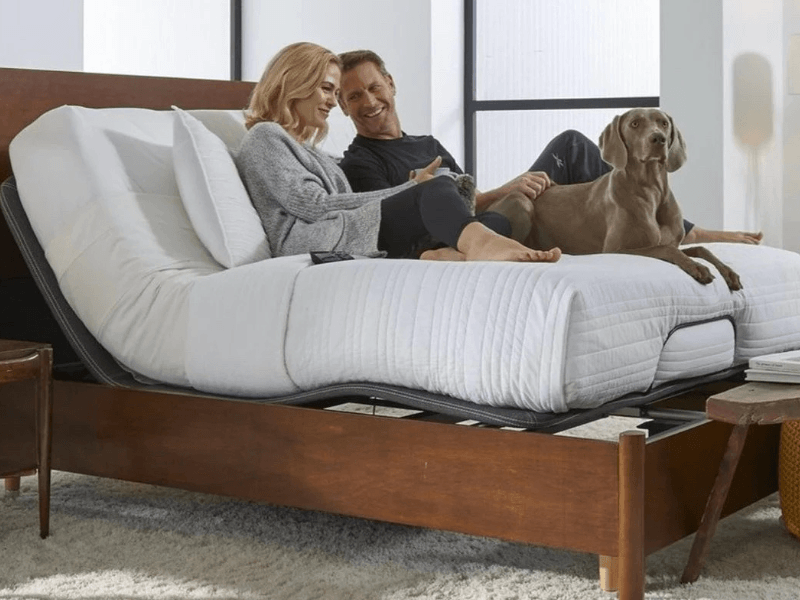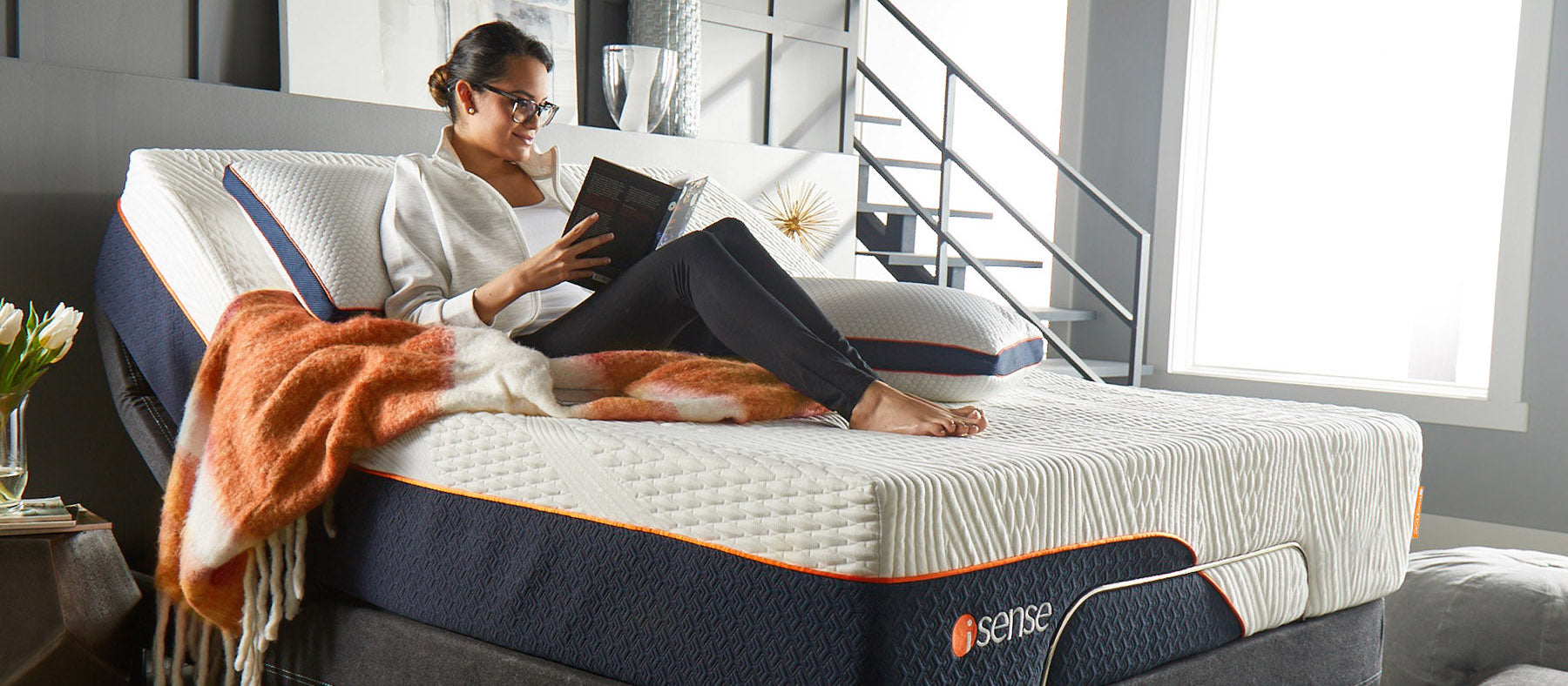Sharing a bed whether with a romantic partner or out of necessity with a roommate can be cozy. However, it can also turn uncomfortable with one person snoring and stretching, and the other tossing and turning. In fact, it can be a challenge trying to find a balance between quality sleep and being a respectful bed-sharing partner.
Worry not. In this blog post, we'll show you how to share a bed and still get a good night's sleep by providing you with practical tips and tricks that you can use to make your experience a comfortable and peaceful one. So, grab a comfy pillow, settle in for a good read, and get ready to learn how to rest easy side by side in the same bed!
Quick Overview
To help both people in the bed get a good night's rest, establish guidelines for movement and noise levels. Investing in separate blankets, pillows, and beds that can be moved apart will also help ensure everyone gets adequate rest.
Assessing Your Bed Accoutrements
Assessing Your bed accouterments is an essential step in determining how comfortable and restful your shared sleep environment will be. The quality of your mattress, pillows, and bedding all play a critical role in getting the most out of a shared sleep session. Generally speaking, you want a mattress that offers you both your preferred levels of comfort, support and pressure-relief. You might choose an innerspring mattress, a memory foam, hybrid, or adjustable firmness mattress. High-quality pillows with adjustable neck support are also important for keeping your neck aligned, which aids with circulation into your head and shoulders. Finally, consider purchasing high thread count sheets and comforters that are comfortable, breathable, and soft to the touch - these components go a long way in helping you achieve a good night's sleep.
That said, one must bear in mind that everyone has different preferences when it comes to their sleeping environment - so take time to identify what works best for both partners before investing in expensive bedding upgrades. Whatever your choice may be, always ensure that both partners feel equally comfortable and that all items work together synergistically for optimal restfulness.
With the right combination of accouterments in place, you have laid the necessary groundwork to start determining the amount of space that both partners need to feel fully rested - which is the topic we will discuss next.
Main Summary Points
When setting up a shared sleep environment with a partner, assess the bed accessories for comfort and restful sleep. Consider the comfort and support of your current mattress, high-quality pillows with adjustable loft and neck support, and high thread count sheets and comforters that are comfortable, breathable, and soft to the touch. Everyone has different preferences about their sleeping environment so be sure to test out different combinations before investing in an expensive upgrade. By doing this, one will create the groundwork necessary to start determining the amount of space both partners need to feel fully rested.
Determining the Amount of Space in Your Bed
Determining the amount of space in your bed can be a tricky issue when it comes to having two people in the same sleeping surface. Do you get a bigger bed, or just put up with the space constraints? While we all would love the luxury and freedom of more space, it may not necessarily be feasible for all couples.
On one hand, having enough space gives both people the opportunity to comfortably move around in the bed without disturbing their partner, leading to a better night's sleep. Wider beds are also beneficial for couples that have different preferences for temperature or covers, since each person can adopt their own configuration without interfering with the other. Additionally, if one person is an especially restless sleeper who kicks and moves around frequently during the night, having enough space will ensure those movements don't disturb their partner too much.
On the other hand, larger beds typically cost more money and may not fit easily into bedrooms of all sizes. Furthermore, couples that have been together a long time may already be used to sharing smaller spaces in bed and might not need a lot of extra room. Therefore, depending on your living situation, budget and level of comfort with sharing close quarters, you can decide what size bed works best for you and your partner – potentially starting out smaller and upgrading later.
In any case, once you've determined what kind of space arrangements work best for you as a couple it's time to create a comfortable configuration to ensure you both get an optimal night's sleep. This will involve laying out the bedding properly which is much easier on bigger beds but still possible on smaller ones with some creative rearrangement.
Creating a Comfortable Configuration for Two People
Creating a comfortable configuration for two people is an essential component for getting a good night's sleep if you’re sharing the bed with a partner. What works best in terms of configuration will depend on your body shape and size as well as how much space you have in the bed.
If you want to maximize the space between you and your partner, it’s best to not sleep head to toe and instead adopt what’s referred to as the “divided sleep arrangement.” This involves positioning two single mattresses side by side with an optional pillow barrier in between them. It keeps both partners relatively centered, allowing each person to rest undisturbed. This arrangement is a bit more extreme and purchasing two mattresses is not always an ideal.
Ultimately, no matter which way you go, it's important to make sure that you're both comfortable and that there's enough room so neither of you gets kicked off the mattress or stuck in one corner during the night. Now that you know what kind of layout makes sense for your particular sleeping arrangement, it’s time to move onto another crucial aspect — finding the right mattress.
Sharing the Mattress
Sharing the mattress might be one of the most difficult challenges when two people are residing in the same bed. If you and your co-sleeper prefer different levels of firmness, this can be a particular issue. Sleep types and comfort preferences vary across individuals, making it harder to find a mattress that suits both partners well. Even if you have found a high-quality mattress that provides good comfort for both, remember to keep up with proper maintenance such as use of a mattress protector.
Different strategies should be discussed here. For instance, on top of sharing mattresses, one partner may prefer an adjustable mattress for sleeping arrangements — allowing them to adjust the firmness of their sleeping surface. There are adjustable air beds but these usually do not offer enough support in the long run. Adjustable air beds usually are topped with a layer of foam over a large air chamber. When you lay on this air chamber, the air moves away from you, creating a hammocking effect. With both partners in the bed potentially moving through the night, you might experience dips and a lot of movement.
There are also adjustable firmness mattresses, such as those built by iSense. The iSense Hybrid Premier is constructed with the best of foam, pocket coils, and targeted air chambers. The iSense Classic is constructed using layers of premium foam and targeted air chambers. Each of these mattresses offer twenty different firmness settings on each side of the bed, each with varying levels of comfort and support. However, every setting offers the same level of pressure relief, providing you both with a sturdy sleep surface you can count on. This dual-firmness makes it simple for each parter to find their perfect level of comfort.
On the other hand, there is evidence that sleeping on a shared mattress promotes more closeness between two partners, providing an intimate setting conducive to better slumber over time. Ultimately, it is important to think about how comfortable you are in sharing space and how much privacy or contact works best for each person's sleep needs — so consider all possible options before committing to one type of set-up.
During the late night hours, excessive movement in bed can also disrupt your partner's sleep — causing both parties to feel tired the next day. To reduce motion transfer while sharing a single mattress, couples can use mattresses with advanced layers or specialty foams like memory foam and hybrid foam that are designed to absorb energy and isolate movement in one section of the bed from another.
Regardless which strategy you choose for sharing your mattress, there may still be moments when you cannot avoid waking up each other at night due to different comfort levels or noises when moving during sleep. Discuss these issues openly with your partner so that everyone is aware of changes necessary for quality restful nights.
It is wise to establish some type of pre-sleep routine that works for both partners; this helps in establishing boundaries within the sleeping environment, helping both partners feel respected and aided towards restful relaxation at night. With this insight into your own and your partner's sleep habits, it may be easier to evaluate flexible solutions as well as find diverse ways to finetune your respective needs.
No matter what decision you make regarding how best to share a single mattress, setting up multiple space saving solutions can help create a relaxing sleep sanctuary while maximizing available space in small bedrooms — hence why our next step will focus on utilizing all space efficiently while promoting restorative slumber in the long term.
Setting Up Multiple Space Saving Solutions
Once you choose the mattress, it's time to furnish the bedroom with creative solutions that help make the most of the shared space. One popular solution for couples sharing a bed is a bed frame with drawers or shelves. This can help provide storage for individual items and create an open space on each side of the bed for partners to sleep without feeling overcrowded.
When it comes to choosing these solutions, couples must debate both sides. On one hand, creating additional spaces could promote relaxation and comfort, but on the other, this could also create physical boundaries between partners. Partners should consider whether they want added physical space or prefer less furniture that prioritizes more intimate contact through tactile moments, like hugging and cuddling. The best option varies depending on individual needs and relationship dynamics — some couples might benefit from having extra private spaces around them even if they're sleeping in a shared bed, while others might not need any physical barriers in their comfortable closeness with one another.
What’s important is that couples don’t feel rushed into making rash decisions about buying expensive furniture that won’t actually satisfy their needs or fit the size of their room. A little research combined with honest conversations about what works for them can lead to smart purchases and arrangements that create positive energy and a serene environment for both partners.
Now that we’ve discussed setting up multiple space-saving solutions, let’s turn our attention to how couples can remain intimate while sharing close quarters in their bed. It all starts with finding ways to keep things comfortable and non-intimidating while preserving physical connection each night.
Creating a Pleasant Sleep Environment
Now that you have some practical solutions for how to share a bed without feeling uncomfortable, it's important to address the emotional side of being in such close physical proximity. Providing non-intimidating touchy-feely moments is an effective way to bond and feel physically connected without feeling as if one person is invading the privacy of another.
There are a few ways you can go about doing this. One option is to give a gentle foot massage, or hold hands while falling asleep. Another way could be initiating gentle cuddles or side hugs during the night. Debate surrounding whether people should involve non-intimidating touchy-feely moments while sharing a bed centers around the level of comfort each partner feels when engaging in such acts infrequently. Some people find pleasure in these acts, while others might find them too pressuring or unwelcome depending on their personal relationship dynamics and preferences. Ultimately, it's up to the two being shared a bed to decide what would work best for both of them.
In terms of evidence for this case, research has shown that couples who incorporate more physical affection into their relationship tend to be more satisfied with their relationships in general, having higher levels of commitment and fewer instances of conflict than those who do not indulge in as much physical affection. Therefore, if both partners feel comfortable with incorporating gentler forms of physical contact when sharing a bed, it could potentially enhance the emotional intimacy between them and make the experience even more enjoyable.
As important as it is to be mindful of one another's boundaries when considering setting up multiple space saving solutions and providing special moments while sharing a bed, the communication aspect should not be neglected either. It's important to talk about sleep needs and preferences before trying out any new sleeping arrangements so that everyone involved feels heard and respected throughout the process. When done tactfully, this will set the foundation for many restful nights in the future.
Talking About Sleep Needs and Preferences
Although providing non-intimidating touchy-feely moments can certainly help in the bedroom, it is just as crucial to have honest conversations about sleep needs and preferences. Studies have shown that couples who are able to openly communicate their sleeping needs tend to have better quality rest and more rested relationships.
When discussing sleep preferences, each partner’s individual expectations should be considered. For example, some individuals enjoy complete darkness for optimal sleep quality, while others prefer a nightlight. Others might prefer that the temperature of the room be slightly cooler or warmer than the other person prefers. It is important to determine what works best for both partners’ sleeping needs before heading to bed each night.
Having regular conversations (not just at bedtime) about wants and needs can be helpful in establishing healthy sleeping habits. By talking openly and honestly with their partner regarding sleeping preferences and topics like sleep apnea or snoring, couples can work together to ensure everyone gets a good night’s rest.
Shifting discussions away from specifics and onto a broader conversation can also be beneficial. For instance, stress levels, diet and exercise patterns all influence how well one sleeps - ask your partner how their day was or talk about upcoming events that may have them feeling anxious or stressed. Understanding their emotional landscape can help you adjust your space accordingly for a better night's sleep.
Additionally, taking time for activities such as reading or having a relaxing cup of tea before heading to bed can help reduce stress levels which improves sleep quality for both partners. Open communication between partners helps create an environment where each person feels acknowledged and respected in regard to their individual sleep needs and personal boundaries. Employing these strategies helps couples share a bed successfully while still obtaining the restful sleep they need.
- According to a 2019 survey, 40% of couples said that they often or always experience interrupted sleep due to their partner’s movements.
- Research conducted in 2018 showed that the ideal temperature for sleeping is approximately 65°F (18°C).
- A study published in 2015 revealed that using separate sheets and blankets can help reduce disruptions and improve comfort during sleep.
Common Questions and Responses
Is sharing a bed unhealthy for my overall sleep quality?
No, sharing a bed is not necessarily unhealthy for your overall sleep quality. In fact, a large body of research has shown that sleeping with someone can be beneficial. Sharing a bed with a partner can provide additional comfort and security, allowing both individuals to relax and feel less anxious. It can also increase levels of intimacy and communication, leading to improved emotional wellbeing and higher quality sleep for both people. To get the most out of shared bedtime though, it’s important to have better communication about each person’s sleep needs and preferences. Working together to find solutions and compromises will help both parties get a good night's rest.
What are the benefits and drawbacks of sharing a bed?
The benefits of sharing a bed are plentiful. One major benefit is the feeling of companionship and intimacy that comes from sleeping in close proximity to someone. Sharing a bed can also be helpful for people who struggle to sleep alone, as having their partner close by can help them relax and feel at ease. Along with this, sharing a bed can provide a sense of security and comfort to people who need reassurance that they’re safe throughout the night. Additionally, sharing a bed can save space and make it easier to keep an eye on children if they move around or wake up in the middle of the night.
On the other hand, there are some drawbacks to sharing a bed. It can become uncomfortable if two people have different sleeping preferences. Additionally, too much movement or sound from one partner may disrupt or wake up the other partner during their slumber. Furthermore, couples who are used to sleeping independently may find it difficult to adjust to the new dynamic of sleeping alongside someone else.
What tips and tricks can help couples sleep better when sharing a bed?
- Set up boundaries: It is important for both partners to decide on the bed’s ‘rules’ before sleeping in it. Establish boundaries such as what time lights should be turned off, when to stay quiet and the type of physical contact that is okay during sleep.
- Sleep in different positions: Some people have difficulty sleeping in the same position as their partner. It is not necessary to maintain the same sleep position as your partner, though.
- Keep the temperature even: Even if one partner is hot and the other cold, try to keep the room temperature at a setting you both can agree on. This will help both partners become more comfortable and enjoy a better night's rest when sharing a bed together.
- Invest in a larger bed: If possible, opt for a larger bed so that each person has their own space while they sleep. A king size mattress can help couples maintain individual comfort while still being close enough to each other during the night.
- Use separate blankets: Cuddling is nice, but separate blankets can make all the difference when it comes to getting quality sleep. Each person can use their own blanket without worrying about disrupting the other’s sleep or having them steal it during the night.
- Wear headphones: Wearing earphones or earplugs with noise canceling properties can help to ensure that sounds such as snoring or one waking up earlier does not disturb the other person.
- Use a sleep mask: If one partner prefers a pitch black environment or perhaps one wakes up earlier than the other, a sleep mask is a great solution. It helps block out unnecessary light that can cause premature awakenings.
Sharing a sleep space with your partner is not difficult when you have the right tools and resources at your disposal. Choosing the right mattress is the first place to start. Adjustable mattresses such as those by iSense offer adjustable firmness on each side of the bed so each partner can choose their level of comfort and support, with consistent pressure relief and motion isolation. The company’s 180-Night trial ensures that you’re able to try out the mattress with your partner for at least 45 nights. This enables your body time to adjust to the new sleep surface.






















